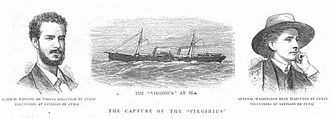Virginius Affair facts for kids
The Virginius Affair was a big disagreement between countries. It happened from October 1873 to February 1875. The countries involved were the United States, the United Kingdom, and Spain. At that time, Spain ruled Cuba. This event took place during a war called the Ten Years' War.
The Virginius was a fast American ship. People fighting for Cuba's freedom hired it. They used it to bring fighters and weapons to Cuba. Their goal was to fight against the Spanish government there. Spanish forces captured the ship. They wanted to treat the people on board as pirates and execute them. Many of these people were American and British citizens. Spain executed 53 people. But they stopped when the British government stepped in.
During this time, some people thought the U.S. might go to war with Spain. But leaders chose to talk things out. The Spanish government changed leaders several times during the talks. An American official, Caleb Cushing, helped solve the problem. Spain agreed to pay $80,000 to the families of the Americans who were executed. British families had already received money from Spain. This event showed how important talking can be. U.S. Secretary of State Hamilton Fish helped keep the peace. He prevented a costly war between the U.S. and Spain. The Virginius Affair also led to the U.S. Navy becoming stronger. Its ships were not as good as Spain's after the American Civil War.
Contents
What Was the Ten Years' War?
After the American Civil War, Cuba was still under Spanish rule. Slavery was still legal and common there. On October 10, 1868, a revolution began. It was called the Ten Years' War. Cuban landowners, led by Carlos Manuel de Céspedes, started it. Spain used its military to stop the rebellion. In 1870, U.S. Secretary of State Hamilton Fish convinced President Grant not to support the Cuban rebels. So, the United States tried to stay neutral with Spain.
As the war in Cuba continued, people from other countries wanted to help. They supported the Cuban fight for freedom. People in the U.S. even bought special bonds to help the Cuban resistance. One American who supported Cuba was John F. Patterson. He bought a ship that used to belong to the Confederacy. It was named Virgin. He renamed it Virginius. The way Patterson bought the Virginius later became a big issue. The Cuban rebellion ended in 1878. Spanish general Arsenio Martínez-Campos pardoned all the Cuban rebels.
The Ship Called Virginius
The Virginius was a small, very fast ship. It had side-wheels. It was built in 1864 in Glasgow, Scotland. Its original name was Virgin. During the American Civil War, it was a blockade runner. This meant it secretly carried goods between Havana and Mobile, Alabama, for the Confederacy. The United States captured it on April 12, 1865.
In August 1870, an American named John F. Patterson bought the Virginius. He was secretly working for a Cuban rebel leader, Manuel Quesada. Two other Americans, Marshall O. Roberts and J.K. Roberts, were also involved. The ship's first captain was Francis Sheppherd. Patterson and Shepphard registered the ship in New York. They paid $2,000 as a bond. Patterson swore he was the only owner. But the real goal was to carry fighters, weapons, and supplies to help the Cuban rebellion.
For three years, the ship helped the Cuban rebels. U.S. Navy ships, like USS Kansas and USS Canandaigua, sometimes protected it. Spain said the ship was illegal. They tried very hard to capture it.
How Did Americans React?
When the Virginius was first captured, newspapers were careful in their reporting. But as news of the executions spread, some newspapers became very angry. They pushed for the U.S. to get involved and go to war. The New York Times said that if the executions were illegal, war should be declared. The New York Tribune said Spain's actions meant "the death knell of Spanish power in America." The New York Herald demanded that Secretary Hamilton Fish resign. It also wanted the U.S. to recognize the Cuban rebels as a real fighting force. The National Republican thought war with Spain was coming. It encouraged people to buy Cuban bonds. The American public felt insulted by the executions. They wanted the U.S. to act. Protests happened in cities like New Orleans, St. Louis, and Georgia. People wanted to help Cuba and get revenge on Spain.
The British Minister to the United States, Sir Edward Thornton, believed Americans were ready for war. A large meeting in New York on November 17, 1873, was led by William Evarts. He later became Secretary of State. This meeting took a calmer approach. They passed a resolution saying war would be needed, but sad, if Spain saw their defense against "savage butchery" as a reason for war.
What Happened Next?
When the Virginius affair began, a Spanish ironclad ship, the Arapiles, was in New York Harbor. It was there for repairs. This made the U.S. Navy realize something important. They did not have any ship that could defeat such a powerful vessel. U.S. Secretary of War George M. Robeson believed the U.S. Navy needed to become strong again.
Congress quickly ordered the building of five new ironclad ships. They also sped up repairs for several other ships. The USS Puritan and four Amphitrite-class monitors were built because of the Virginius war scare. All five of these ships later fought in the Spanish–American War in 1898.
Images for kids
See also
 In Spanish: Asunto del Virginius para niños
In Spanish: Asunto del Virginius para niños


